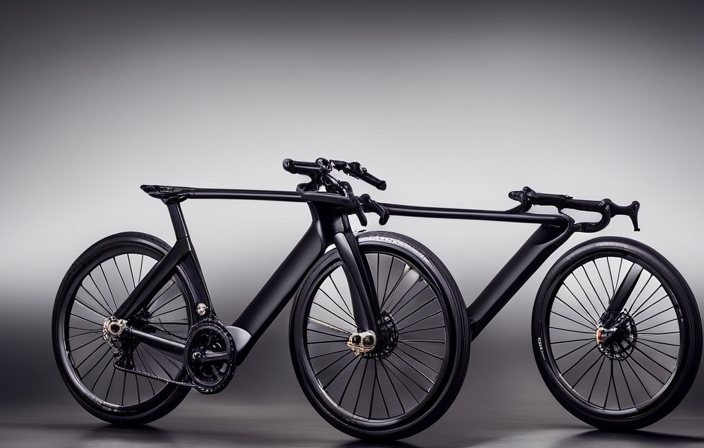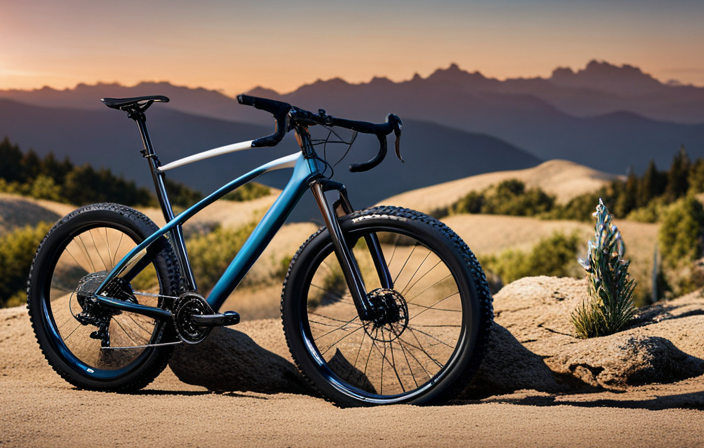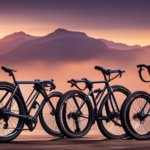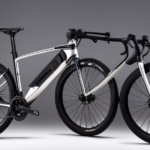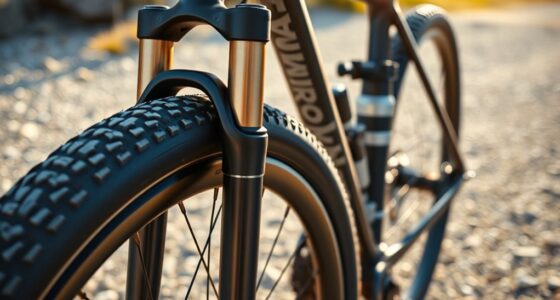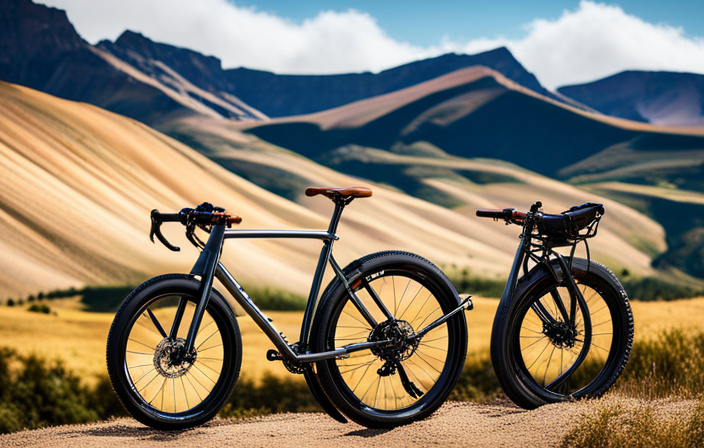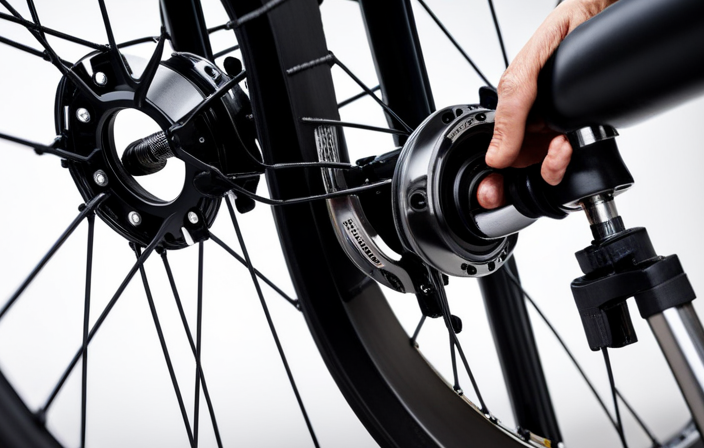It is often stated that speed is crucial in cycling. Particularly, when tackling gravel roads, the importance of speed is significantly heightened.
In this article, I will share with you a comprehensive guide on how to transform your bike into a fast and efficient gravel machine. From choosing the right frame to optimizing tire selection and pressure, upgrading components, and fine-tuning bike fit – we’ll leave no stone unturned in our quest for ultimate speed on those rough terrains.
So let’s dive in and unlock the secrets of making a fast gravel bike!
Key Takeaways
- Choosing the right bike frame considering weight, aerodynamics, and custom options for optimized geometry and fit.
- Optimizing tire selection by considering tread patterns, width, and balancing traction and efficiency on different terrains.
- Adjusting tire pressure within the recommended range for speed and control, considering factors like rider weight and terrain conditions.
- Upgrading to a lightweight wheelset with carbon fiber or aluminum alloy rims, wider rims for better tire support, and attention to spoke count and lacing pattern for stiffness and responsiveness.
- Installing a gravel-specific groupset for enhanced performance on off-road terrain, improved durability, a wider range of gear options, and optimized speed and efficiency with proper gear ratios.
Choose the Right Bike Frame
When choosing the right bike frame, it’s important to consider factors such as weight and aerodynamics. These aspects play a crucial role in making a fast gravel bike. One option to explore is getting a custom frame designed specifically for your needs. A custom frame allows you to optimize the geometry and fit of the bike, ensuring maximum comfort and performance.
Another key consideration is the choice of frame material. Different materials offer varying levels of stiffness, compliance, and weight. Carbon fiber frames are lightweight and provide excellent vibration damping properties, making them popular among many gravel riders. Aluminum frames are also a viable option, offering good strength-to-weight ratio at an affordable price point.
To make an informed decision between these options, it’s essential to compare their characteristics and assess how they align with your riding style and preferences. Factors like ride quality, durability, and overall cost should be taken into account.
Once you have chosen the right bike frame, you can move on to optimizing tire selection for improved speed on gravel roads. By finding the perfect balance between traction and rolling resistance in your tires, you can enhance your overall performance on rough terrain without compromising efficiency on smoother surfaces.
Optimize Tire Selection
To optimize tire selection on your gravel bike, you should consider factors such as tread pattern and tire width. When it comes to tire tread patterns, there are a few options that can enhance your performance on different terrains:
-
Knobby Tires: These tires offer excellent traction on loose surfaces like gravel and dirt. They have deep, aggressive treads that dig into the ground for maximum grip.
-
Semi-Slick Tires: If you ride mostly on hard-packed gravel or pavement, these tires are a great choice. They feature a smooth center tread for low rolling resistance, with slightly more aggressive side knobs for cornering stability.
-
All-Round Tires: As the name suggests, these tires strike a balance between knobby and slick designs. They provide decent traction on various surfaces while maintaining good rolling efficiency.
In addition to tread patterns, tire width is another crucial consideration. Wider tires generally offer better stability and comfort over rough terrain. However, narrower tires provide lower rolling resistance on smoother surfaces.
Optimizing your tire selection is just one aspect of making a fast gravel bike. Next, we’ll explore how adjusting tire pressure can further enhance speed and control without compromising performance.
Adjust Tire Pressure for Speed and Control
For better speed and control, you should consider adjusting your tire pressure on your gravel bike. The right tire pressure can greatly improve your cornering skills and give you a more confident ride.
When it comes to gravel biking, finding the perfect tire pressure is crucial. Too high of a pressure and you’ll bounce around uncontrollably on rough terrain, while too low of a pressure will make pedaling inefficient and increase the risk of pinch flats.
One of the main benefits of wider tires is their ability to run at lower pressures without sacrificing performance. By lowering the tire pressure, you increase the contact patch with the ground, which enhances traction and control. This allows you to take corners more aggressively without losing grip or sliding out.
To find the ideal tire pressure for your gravel bike, start by experimenting within the recommended range provided by the manufacturer. Factors such as rider weight, terrain conditions, and personal preference can influence your optimal tire pressure. I recommend starting on the higher end of the range and gradually decreasing until you find a sweet spot that balances speed and control.
Now that we’ve optimized our tire selection and adjusted our tire pressure for improved performance on gravel roads, let’s move on to upgrading to a lightweight wheelset for even better speed and agility.
Upgrade to a Lightweight Wheelset
Upgrading to a lightweight wheelset can significantly enhance your speed and maneuverability on the gravel. A lighter wheelset reduces rotational mass, allowing you to accelerate faster and maintain speed more easily. This is especially important when riding on rough terrain where every pedal stroke counts. Additionally, a lighter wheelset improves the bike’s handling by reducing the gyroscopic effect, making it easier to navigate tight turns and corners.
When choosing a lightweight wheelset for your gravel bike, there are a few factors to consider. First, look for rims made from materials like carbon fiber or aluminum alloy, as they offer a good balance between weight savings and durability. Consider the width of the rim as well; wider rims provide better tire support and traction on loose surfaces.
Moreover, pay attention to the spoke count and lacing pattern. Opting for fewer spokes can save weight but may sacrifice some strength. As for the lacing pattern, radial or straight-pull spokes tend to be stiffer and more responsive.
In conclusion, upgrading to a lightweight wheelset has numerous benefits in terms of speed and maneuverability on gravel roads. Once you’ve selected the right wheelset for your needs, it’s time to move onto the next step: installing a gravel-specific groupset that further optimizes performance in off-road conditions.
Install a Gravel-Specific Groupset
Installing a gravel-specific groupset enhances your bike’s performance on off-road terrain. A gravel specific drivetrain is designed to withstand the demands of rough terrains and provide you with the optimal gear ratios for efficient power transfer. Here are two key benefits of using a gravel-specific groupset:
-
Improved Durability: Gravel riding puts extra stress on your bike components, especially the drivetrain. A gravel-specific groupset is built to handle these challenges by incorporating stronger materials and reinforced designs. This ensures that your drivetrain can withstand the constant vibrations, impacts, and debris encountered while riding off-road.
-
Proper Gear Ratios: Riding on different surfaces requires varying levels of power output. A gravel-specific groupset allows you to have a wider range of gear options to tackle steep climbs, loose surfaces, and fast descents effectively. It ensures that you always have access to the right gear ratio for any given situation, optimizing both speed and efficiency.
By installing a gravel-specific groupset, you not only enhance your bike’s durability but also ensure that you have the proper gear ratios for conquering off-road challenges with ease.
In the next section, we will explore how to optimize gear ratio for even greater speed and efficiency.
Optimize Gear Ratio for Speed and Efficiency
To achieve greater speed and efficiency, you can optimize the gear ratio on your bike. Gear ratio optimization is essential for maximizing power transfer and finding the right balance between speed and cadence. By adjusting the front chainring size and rear cassette combination, you can fine-tune your bike’s gearing to suit different terrains and riding conditions.
When it comes to gear ratio optimization, training techniques for speed and efficiency play a crucial role. Interval training, hill repeats, and high-intensity interval sessions can help improve your power output and pedaling technique. These workouts allow you to push harder in higher gears while maintaining a smooth cadence, ultimately enhancing your overall performance on the gravel bike.
Additionally, it’s important to consider your fitness level when optimizing gear ratios. If you’re new to gravel biking or have lower fitness levels, starting with easier gears will allow you to spin at a higher cadence without exerting too much effort. As your strength improves over time, gradually increase the difficulty of your gears for more challenging rides.
Optimizing gear ratios is just one aspect of improving speed and efficiency on a gravel bike. Another important upgrade is switching to a stiff and lightweight fork that enhances handling and responsiveness on rough terrain while minimizing energy loss through flexing. This upgrade will further enhance your riding experience by providing better control and reducing fatigue during long rides.
Upgrade to a Stiff and Lightweight Fork
Switching to a stiff and lightweight fork improves handling and responsiveness on rough terrain, enhancing your riding experience. When it comes to gravel biking, having a fork that balances stiffness with compliance is crucial.
A stiff fork helps to transmit power efficiently from your legs to the wheels, allowing you to accelerate quickly and maintain speed. On the other hand, compliance in the fork allows for better absorption of vibrations and impacts, resulting in a smoother ride.
To achieve this balance, manufacturers use lightweight materials and construction techniques. Carbon fiber forks are popular among gravel cyclists due to their excellent stiffness-to-weight ratio. These forks provide optimal power transfer without adding unnecessary weight to your bike. Additionally, carbon fiber has inherent damping properties that help reduce road chatter and vibration.
Upgrading your fork not only enhances performance but also increases comfort during long rides on varied terrain. The improved handling allows you to confidently tackle technical sections while maintaining control over the bike.
This sets you up for a smoother transition into the next section about installing aero handlebars and accessories, which further enhance aerodynamics and comfort on fast gravel rides.
Install Aero Handlebars and Accessories
For a more streamlined and comfortable riding experience, consider adding aero handlebars and accessories to your setup. Aero handlebars are designed to reduce drag by optimizing your body position on the bike. By positioning your hands closer together and lowering them, you can decrease wind resistance and improve aerodynamics. This not only allows you to ride faster but also reduces fatigue over long distances.
In addition to aero handlebars, there are various accessories available that further enhance your aerodynamic performance. These include clip-on aerobars, which provide an extended reach for a more aggressive riding position, and armrest pads that offer comfort during long rides. By incorporating these accessories into your gravel bike setup, you can achieve an optimal balance between speed and comfort.
To help visualize the benefits of aero handlebars and accessories, take a look at the table below:
| Aero Handlebars | Clip-on Aerobars | Armrest Pads | |
|---|---|---|---|
| Benefits | – Reduced drag | – Extended reach | – Enhanced comfort |
| – Improved speed | – Aggressive position |
By installing aero handlebars and accessories on your gravel bike, you can significantly improve your riding experience. However, if you’re looking to further improve aerodynamics, the next section will discuss how to achieve this with aero frames and components without compromising speed or comfort.
Improve Aerodynamics with aero frames and components
Enhancing your riding experience can be achieved by improving aerodynamics with aero frames and components. By investing in these upgrades, you can not only reduce wind resistance but also improve bike handling, allowing you to ride faster and more efficiently on gravel terrain.
To achieve optimal aerodynamics, consider the following:
-
Aero Frames: Upgrading to an aero frame reduces drag by minimizing turbulence caused by air flow around the bike. These frames are designed to slice through the wind, making your ride smoother and faster.
-
Aero Forks: Investing in an aero fork improves stability and reduces wind resistance. It enhances the overall handling of your bike, allowing for better control when navigating rough gravel surfaces.
-
Deep-section Wheels: These wheels offer improved aerodynamics by reducing drag from crosswinds. They allow for better speed maintenance while ensuring stability during fast descents or sudden turns.
-
Integrated Cockpits: An integrated cockpit combines handlebars and stem into one unit, optimizing aerodynamics. This setup helps streamline airflow around your front end, further reducing wind resistance.
By incorporating these aero frames and components into your gravel bike setup, you can enhance both speed and control on the trails. Upgrade to a carbon fiber seatpost for further improvements in performance and comfort.
Transitioning into the next section about upgrading to a carbon fiber seatpost…
Upgrade to a Carbon Fiber Seatpost
Upgrading to a carbon fiber seatpost can significantly improve your riding experience on the trails. Carbon fiber seatposts are known for their lightweight construction and ability to absorb road vibrations, resulting in a smoother and more comfortable ride. Compared to aluminum seatposts, carbon fiber seatposts offer greater stiffness and strength while being lighter in weight. This makes them an ideal choice for gravel biking enthusiasts who want to enhance their performance.
The benefits of using an aero seatpost are not limited to just weight reduction. By reducing drag and improving aerodynamics, aero seatposts can help you achieve higher speeds with less effort. The streamlined design of these seatposts minimizes air resistance, allowing you to glide through the wind more efficiently. This is especially beneficial when riding at high speeds or during races where every second counts.
To showcase the advantages of upgrading to a carbon fiber seatpost, here is a comparison table:
| Carbon Fiber Seatpost | Aluminum Seatpost | |
|---|---|---|
| Weight | Lightweight | Heavier |
| Strength | High | Moderate |
| Comfort | Excellent | Good |
| Aerodynamics | Superior | Average |
By upgrading your bike with a carbon fiber seatpost, you can enjoy the benefits of reduced weight, increased strength, enhanced comfort, and improved aerodynamics. These features will undoubtedly contribute to a faster and more enjoyable gravel biking experience.
In the next section, we will explore another upgrade that can further optimize your gravel bike’s performance: installing tubeless tires for reduced rolling resistance…
Install Tubeless Tires for Reduced Rolling Resistance
After upgrading to a carbon fiber seatpost on my gravel bike, I was eager to further enhance its performance. That’s when I decided to install tubeless tires for reduced rolling resistance.
Tubeless tire installation techniques can be a bit tricky, but the benefits they offer for gravel biking are well worth it.
Firstly, tubeless tires eliminate the need for inner tubes, which significantly reduces the overall weight of the bike. This reduction in weight translates into improved acceleration and maneuverability on rough terrain. Additionally, without tubes, there is no risk of pinch flats or punctures caused by sharp objects penetrating the tire.
To install tubeless tires properly, I started by cleaning the rim thoroughly and applying a layer of tubeless rim tape. Then, I carefully mounted the tire onto the rim and added sealant through the valve stem. After ensuring that all sides of the tire were seated evenly on the rim, I inflated it with a high-volume pump.
The benefits of using tubeless tires for gravel biking are numerous. They provide lower rolling resistance compared to traditional clincher tires since there is no friction between rubber and an inner tube. Tubeless tires also allow me to run lower pressures without worrying about pinch flats or burping out air during hard cornering.
Now that my gravel bike is equipped with tubeless tires, it’s time to explore another upgrade option – lightweight and aerodynamic pedals that will further enhance speed and efficiency on every ride.
Transition: With my bike now having reduced rolling resistance from installing tubeless tires, let’s move on to another step in making a fast gravel bike – using lightweight and aerodynamic pedals.
Use Lightweight and Aerodynamic Pedals
To optimize your gravel biking experience, consider utilizing lightweight and aerodynamic pedals. Lightweight pedal materials are essential for reducing the overall weight of your bike, which can significantly improve acceleration and climbing performance. Look for pedals made from materials such as carbon fiber or titanium, as they offer excellent strength-to-weight ratios. These lightweight options will make a noticeable difference in how effortlessly you can propel your bike forward.
In addition to weight reduction, the importance of pedal aerodynamics should not be underestimated. Aerodynamic pedals minimize wind resistance and drag, allowing you to maintain higher speeds with less effort. Opt for pedals with streamlined shapes and minimal surface area exposed to the wind. This design will help you cut through the air more efficiently and conserve energy during long rides.
When considering pedal options, imagine yourself gliding effortlessly over gravel roads while feeling connected to every stroke of power transfer. Picture achieving maximum efficiency with each pedal stroke as you flow through challenging terrain effortlessly.
Now that we have explored the benefits of lightweight and aerodynamic pedals, let’s move on to optimizing bike fit for efficiency and power transfer without compromising comfort or control.
Optimize Bike Fit for Efficiency and Power Transfer
One way to enhance your gravel biking experience is by ensuring your bike fits optimally, promoting efficient power transfer while maintaining comfort and control. Bike fit adjustments and power transfer techniques play a crucial role in achieving this balance. By making specific modifications to your bike’s geometry and component positioning, you can optimize the fit for maximum efficiency.
A key aspect of bike fit is finding the right saddle height. This adjustment allows for proper leg extension during pedaling, optimizing power output and reducing strain on the knees. Additionally, adjusting the saddle position forward or backward can impact how much weight is distributed between the front and rear wheels, affecting handling and overall comfort.
Another important consideration is handlebar height and reach. Properly aligning these components with your body’s proportions ensures an ergonomic riding position that maximizes power transfer while minimizing fatigue. Adjustments such as stem length, handlebar width, and grip positioning can further fine-tune the fit for individual preferences.
To provide a visual representation of various bike fit adjustments, consider the following table:
| Bike Fit Adjustment | Description | Impact |
|---|---|---|
| Saddle Height | Determines leg extension during pedaling | Optimizes power output |
| Saddle Position | Balances weight distribution between wheels | Influences handling |
| Handlebar Height | Aligns with body proportions for an ergonomic position | Maximizes power transfer |
| Handlebar Reach/Width/Grip Positioning | Fine-tunes fit for individual preferences | Minimizes fatigue |
By implementing these bike fit adjustments and employing effective power transfer techniques, you can enhance your gravel biking performance significantly. Now let’s take a look at another important step: reducing weight with carbon fiber components…
Reduce Weight with Carbon Fiber Components
Using carbon fiber components can help decrease the weight of your bicycle, enhancing its performance on the gravel. Carbon fiber is a lightweight and strong material that is commonly used in high-performance bikes. Compared to aluminum components, carbon fiber parts offer several advantages.
-
Weight reduction: Carbon fiber components are significantly lighter than their aluminum counterparts. This reduces the overall weight of the bike, making it easier to accelerate and maneuver on gravel surfaces.
-
Increased stiffness: Carbon fiber has a higher stiffness-to-weight ratio compared to aluminum, resulting in improved power transfer from your legs to the pedals. This translates into more efficient pedaling and better energy transfer.
-
Vibration damping: The inherent properties of carbon fiber help absorb road vibrations, providing a smoother ride on rough gravel terrains.
-
Aesthetic appeal: Carbon fiber components have a sleek and modern appearance that adds a touch of style to your bike.
Reducing the weight of your gravel bike through carbon fiber components not only improves its performance but also enhances your overall riding experience.
In the next section, we will discuss how regular maintenance and cleaning are essential for optimal performance without compromising safety or reliability.
Regular Maintenance and Cleaning for Optimal Performance
Keep your gravel bike performing at its best by regularly maintaining and cleaning it. Regular maintenance is crucial for optimal performance and longevity of your bike.
Start by inspecting the frame, wheels, drivetrain, and brakes for any signs of wear or damage. Replace worn-out parts promptly to prevent further issues.
Cleaning your gravel bike after each ride is essential to remove dirt, mud, and debris that can accumulate on various components. Use a soft brush or sponge with mild soap and water to clean the frame, fork, handlebars, and seatpost. Pay special attention to hard-to-reach areas like the bottom bracket and rear derailleur.
The drivetrain requires extra care as it is exposed to constant dirt and grime. Use a degreaser to remove built-up grease from the chain, cassette, and chainrings. Scrub gently with a brush before rinsing thoroughly.
Don’t forget to check tire pressure regularly as it affects both performance and comfort during rides. Lubricate the chain after cleaning using a specific bicycle lubricant suitable for your riding conditions.
In addition to regular maintenance tasks, consider scheduling professional tune-ups annually or when needed. A professional mechanic can ensure all components are properly adjusted and functioning optimally.
By following these regular maintenance practices and keeping your gravel bike clean, you’ll enjoy smoother rides with improved overall performance while extending the lifespan of your beloved machine.
Frequently Asked Questions
Can I make my current bike faster by just upgrading the wheelset?
Yes, upgrading the wheelset on your current bike can definitely make it faster. By investing in a lighter and more aerodynamic wheelset, you’ll reduce rotational weight and improve overall efficiency.
Additionally, switching to tubeless tires provides numerous benefits like increased traction, lower rolling resistance, and reduced chances of flats.
Upgrading brakes can also enhance your bike’s speed by providing better stopping power and modulation.
How do I choose the right gear ratio for my gravel bike?
Like a well-tuned engine, choosing the right gear ratio for your gravel bike can unlock its true potential.
To improve power transfer on a gravel bike, opt for a gear ratio that allows you to maintain an efficient cadence while providing enough torque for climbing and accelerating.
Additionally, selecting the right tire width is crucial for optimal speed on rough terrain.
Wider tires offer better traction and stability, while narrower ones increase rolling efficiency but sacrifice grip.
Are carbon fiber components worth the investment in terms of speed improvement?
Carbon fiber components are definitely worth the investment if you’re looking to improve speed on your gravel bike.
Carbon frames, compared to aluminum ones, offer a significant weight advantage, resulting in faster acceleration and climbing abilities. The lighter weight translates into less effort required to maintain higher speeds.
Additionally, carbon fiber’s stiffness enhances power transfer, allowing for more efficient pedaling and ultimately contributing to improved overall speed on the bike.
What are some tips for reducing rolling resistance on my gravel bike?
Reducing tire pressure and using tubeless tires are effective ways to minimize rolling resistance on a gravel bike.
Lower tire pressure allows for greater contact area with the ground, enhancing grip and reducing energy loss.
Tubeless tires eliminate friction caused by inner tubes, resulting in smoother rides and improved speed.
By implementing these techniques, you can optimize your gravel bike’s performance and enjoy a faster ride while tackling rough terrains.
How often should I clean and maintain my gravel bike for optimal performance?
For optimal performance, I recommend cleaning and maintaining your gravel bike regularly. The frequency of cleaning depends on how often you ride in different conditions, but a general rule is to clean it after every muddy or dusty ride.
Essential maintenance tasks include lubricating the chain, checking tire pressure, inspecting brake pads and cables, and tightening bolts. By keeping up with these tasks, you’ll ensure your gravel bike performs at its best and lasts longer.
Conclusion
In conclusion, by following these steps, you can transform your gravel bike into a fast and efficient machine.
With the right frame, optimized tire selection, and lightweight components, you’ll experience improved speed and control on any terrain.
One interesting statistic to consider is that upgrading to a lightweight wheelset can decrease rotating weight by up to 1kg, resulting in faster acceleration and easier climbing.
So don’t hesitate to make these modifications and enjoy the exhilarating ride of a fast gravel bike.
